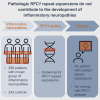Pathologic RFC1 repeat expansions do not contribute to the development of inflammatory neuropathies
- PMID: 38978724
- PMCID: PMC11228429
- DOI: 10.1093/braincomms/fcae163
Pathologic RFC1 repeat expansions do not contribute to the development of inflammatory neuropathies
Abstract
Biallelic expansions of the AAGGG repeat in the replication factor C subunit 1 (RFC1) have recently been described to be responsible for cerebellar ataxia, peripheral neuropathy and vestibular areflexia syndrome. This genetic alteration has also allowed genetic classification in up to one-third of cases with idiopathic sensory neuropathy. Here, we screened a well-characterized cohort of inflammatory neuropathy patients for RFC1 repeat expansions to explore whether RFC1 was increased from background rates and possibly involved in the pathogenesis of inflammatory neuropathy. A total of 259 individuals with inflammatory neuropathy and 243 healthy controls were screened for the AAGGG repeat expansion using short-range flanking PCR and repeat-primed PCR. Cases without amplifiable PCR product on flanking PCR and positive repeat-primed PCR were also tested for the mostly non-pathogenic expansions of the AAAGG and AAAAG repeat units. None of the patients showed biallelic AAGGG expansion of RFC1, and their carrier frequency for AAGGG was comparable with controls [n = 27 (5.2%) and n = 23 (4.7%), respectively; P > 0.5]. Data suggest that the pathologic expansions of AAGGG repeats do not contribute to the development of inflammatory neuropathies nor lead to misdiagnosed cases. Accordingly, routine genetic screening for RFC1 repeat expansion is not indicated in this patient population.
Keywords: CANVAS; RFC1 disorder; chronic inflammatory demyelinating neuropathy; inflammatory neuropathies; multifocal motor neuropathy.
© The Author(s) 2024. Published by Oxford University Press on behalf of the Guarantors of Brain.
Conflict of interest statement
The authors report no competing interests.
Figures


References
-
- Nakamura H, Doi H, Mitsuhashi S, et al. Long-read sequencing identifies the pathogenic nucleotide repeat expansion in RFC1 in a Japanese case of CANVAS. J Hum Genet. 2020;65(5):475–480. - PubMed
Grants and funding
LinkOut - more resources
Full Text Sources
